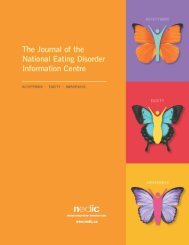NEDIC Conference Journal 2018
Create successful ePaper yourself
Turn your PDF publications into a flip-book with our unique Google optimized e-Paper software.
discrimination based on gender, disability, race or<br />
Indigenous status, along with other social<br />
determinants, such as isolation, are shown to have<br />
significant impact on physiological and psychological<br />
health and wellbeing [21]. WHC attempts to<br />
increase social connection and supports through<br />
support groups, programs that address issues such<br />
as poverty, and/or through prioritizing services to<br />
marginalized communities.<br />
For personal reflection:<br />
What is something you can do to advocate for<br />
inclusion of all shapes and sizes in your<br />
workplace?<br />
If you experience privileges or are awarded<br />
respect based on the size of your body, how can<br />
you use that privilege to support those who are<br />
oppressed or stigmatized based on the size of<br />
their body?<br />
How would the health status of your patients or<br />
clients improve if the social determinants of<br />
health are addressed?<br />
4. Conclusion: Focus on wellness, not<br />
weight<br />
WHC’s decision to focus on wellness not weight<br />
in all aspects of our health care and service delivery<br />
is supported by Tylka et al (2014) [3] and Bacon &<br />
Aphramor’s (2011) [22] review of the empirical<br />
research. Body size is to a large degree genetically<br />
determined [23], [24] and weight is not modifiable<br />
on a sustained basis for most people. Therefore, it is<br />
ethical, responsible, and compassionate to provide<br />
weight neutral care that can actually promote health<br />
behavior change to reduce the risk and treat chronic<br />
diseases.<br />
Specifically within the eating disorder treatment<br />
program, we have observed the therapeutic benefits<br />
that come with our focus on helping clients change<br />
their thoughts, feeling, and behaviours instead of<br />
their weight. This requires preparing clients for the<br />
possibility of body changes during recovery and<br />
acknowledging the grief they may have about weight<br />
change or lack of change in a culture that stigmatizes<br />
bodies that do not conform to societal ideals.<br />
Through cognitive behavioural restructuring and<br />
dialectical behavioural skills such as emotion<br />
regulation, distress tolerance, radical acceptance and<br />
mindfulness, recovery is possible without a focus on<br />
weight change as a measure of success.<br />
In our clinical experience, as clients move<br />
through the eating disorder treatment program, we<br />
have found that clients show a decrease in the<br />
following: disordered food and exercise behaviour:<br />
all or nothing thinking, negative self-talk, isolation,<br />
shame, self-blame, weight preoccupation and<br />
symptoms of anxiety and depression, Many clients<br />
also make improvements to symptoms related to<br />
chronic disease such as lowering their blood<br />
pressure or blood sugar levels. There is also a<br />
measurable increase in self-care and wellnesspromoting<br />
behaviours, body acceptance, selfadvocacy<br />
skills, confidence, and self-worth and selfcompassion.<br />
5. References<br />
[1] Brown, C. and Zimberg, R. (1993). ‘Getting Beyond<br />
Weight’: Women’s Health Clinic Weight Preoccupation<br />
Program. In Brown C. and Jasper, K. (Ed.), Consuming<br />
Passions: Feminist Approaches to Weight Preoccupation<br />
and Eating Disorders Toronto: Second Story Press.<br />
[2] Women’s Health Clinic (2016) Health At Every Size<br />
Values Statement. Retrieved:<br />
http://womenshealthclinic.org/wp-<br />
content/uploads/<strong>2018</strong>/04/HAES-Value-<br />
Statement.pdf?x88868<br />
[3] Tylka, T. L., Annunziato, R. A., Burgard, D.,<br />
Daníelsdóttir, S., Shuman, E., Davis, C., and Calogero, R. M.<br />
(2014). The Weight-Inclusive versus Weight-Normative<br />
Approach to Health: Evaluating the Evidence for<br />
Prioritizing Well-Being over Weight Loss. <strong>Journal</strong> of<br />
Obesity, 2014, Article ID 983495.<br />
doi:10.1155/2014/983495<br />
[4] Patton, G. C., Selzer, R., Coffey, C., Carlin, J. B. & Wolfe,<br />
R. (1999). Onset of adolescent eating disorders: population<br />
based cohort study over 3 years. British Medical <strong>Journal</strong>,<br />
318, 765-768.<br />
[5] Mann, T., Tomiyama, A.J., Westling, E., Lew, A.M.,<br />
Samuels, N. & Chatman, J. (2007). Medicare’s search for<br />
effective obesity treatments: Diets are not the answer.<br />
American Psychologist, 62(3), 220-233. doi:<br />
http://dx.doi.org/10.1037/0003-066X.62.3.220<br />
[6] Fildes, A., Charlton, J., Rudisill, C., Littlejohns, P.,<br />
Prevost, A.T., Gulliford. M.C. (2015). “Probability of an<br />
Obese Person Attaining Normal Body Weight: Cohort<br />
Study Using Electronic Health Records”. American <strong>Journal</strong><br />
of Public Health 105:9, 54-59.<br />
[7] Ochner, C. N., Barrios, D. M., Lee, C. D., & Pi-Sunyer, F.<br />
X. (2013). Biological Mechanisms that Promote Weight<br />
Regain Following Weight Loss in Obese Humans.<br />
30




